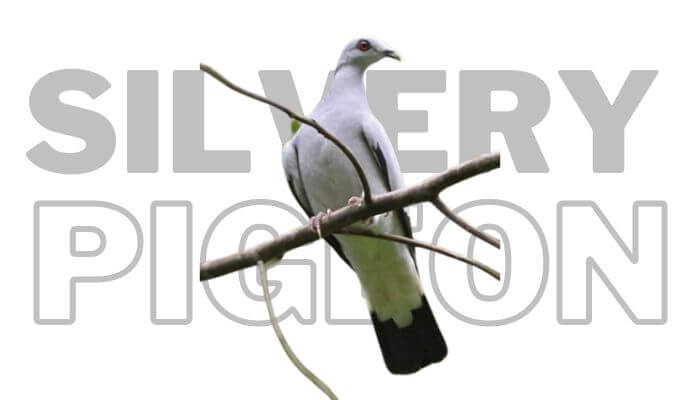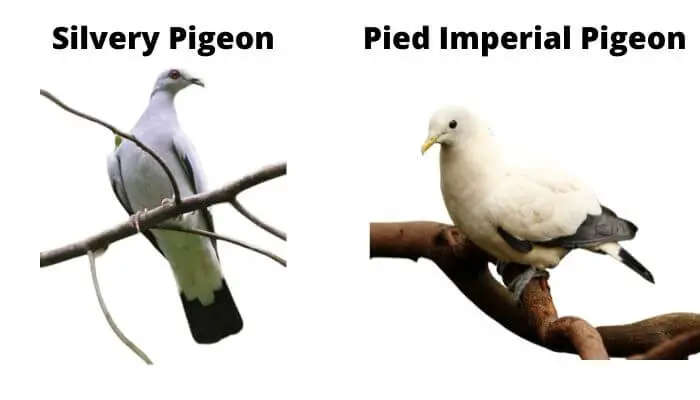The Silvery pigeon is a fairly large species of pigeon that is native to Malaysia and Indonesia.
Named for its coloring, this pigeon is also known as the Silvery wood pigeon or the Grey wood pigeon.

Origins of the Silvery pigeon
The earliest recorded mentions of the Silvery pigeon trace the species to the area of Asia that includes the countries of Malaysia and Indonesia.
The oldest record is from 1850 when a specimen was supposedly collected near the Indonesian city of Pontianak on the Island of Borneo.
The pigeon was given the Latin name Columba Argentina by Charles Lucien Bonaparte in 1857, the “argent” referring to silver.
There is an estimated population of less than fifty mature Silvery Pigeons left in the wild.
Distribution And Habitat
The distribution of the Silvery pigeon is limited. Its most populated range is a few islands in the Barusan chain off Western Sumatra.
This breed was once thought to be extinct in the wild as there were no recorded sightings after 1931. Then in 2008 photographs taken on Simeuelue, near Masokut Island confirmed the species still existed.

Inner image by user:Dysmorodrepanis – Own work, CC BY 2.5, https://commons.wikimedia.org/w/index.php?curid=1052847
The Silvery pigeon was also recorded during the early 20th century on various offshore islands of the Natuna Sea, west of Borneo and also west of Sumatra in Indonesia, as well as on the adjacent land.
It is thought that because of its close resemblance to other species, particularly the Pied imperial pigeon, it may have been misidentified in the period it was thought to be extinct and this resulted in remnant populations being misclassified.

The preferred habitat of the Silvery pigeon is mangrove forest and other similar types of woodland in low-lying offshore islands and coastal areas. Predominantly, they like to dwell at an altitude below 100m ASL.
The Silvery pigeon is believed to wander around following the trails of fresh fruit in season, and the species has also been seen to associate with larger, more abundant flocks of pied imperial pigeon.
Status of the Silvery Pigeon
The Silvery pigeon is one of the endangered pigeons on the IUCN Red list.
It is listed as critically endangered which means there is an estimated population of less than fifty mature birds left in the wild.
This summation, however, is based on a lack of confirmed sightings rather than being able to take a real count.
Conservationists and optimistic Silvery pigeon lovers hope the species is more populous than this and suffers from being hard to be distinguished from the Pied imperial pigeon.
For now, the population of the Silvery pigeon is recorded as being in decline but the known populations are being observed for conservation strategies to be formulated.
Appearance of the Silvery Pigeon
| Wingspan | Length | Weight | Coloring | |
|---|---|---|---|---|
| Silvery pigeon | 42 -45 cm | 34 – 38 cm | 350 g (est) | Pale bluish-gray with black primaries and secondaries. |
| Average Feral Pigeon | 64 – 72 cm | 32 – 37 cm | 300 – 500 g | Bluish grey with some black |
The Silvery pigeon is difficult to distinguish from the more common pied imperial pigeon from a distance although the latter is slightly larger.
Up close, however, there are a few recognizable characteristics of the breed.
In what is seen as an unusual color pattern for a pigeon, the plumage of a Silvery pigeon is a pale silver bluish grey color, with black remiges at the very ends of the tail feathers.
There can also be a green sheen on the feathers on the back of the bird’s neck.
This bird has a sloping forehead and dark red or purple eye wattles.
The beak is chisel shape that is darker at the base and is dusky purple with a pale apple-green tip
The Silvery pigeon’s tail is fan-shaped and its feet are a bluish-grey color that can be mottled with varying amounts of red.
Females are slightly bigger and darker in color than males.
Character of the Silvery Pigeon
Little is known about the character of the Silver pigeon because they have been too elusive for a full study to date.
With their easy assimilation into larger flocks of pied imperial pigeons, it is fair to assume that the two species share a number of similar traits in their behavior and temperament.
The lack of information does not tell us if the Silvery pigeon has the same flying abilities as the Pied imperial pigeon but going on the evidence of its historical range across many islands they are probably equally adept at flight.
Diet of the Silvery Pigeon
The Silvery pigeon forages on tropical forest woodland floors and lower branches of fruit trees to eat fruit and berries. They will follow fruit trails when specific fruits are in season.
Being a wild pigeon, this species will be an opportunistic feeder on occasions when the desired fruits were not available.
Although poorly known, available evidence suggests that the Silvery pigeon wanders seasonally or disperses between islands in response to changes in the food supply.
Silvery Pigeon Mating And Breeding
Little is known about the life cycle because of the lack of observant studies but the Silvery pigeon breeds in bird’s nesting colonies, most likely over an extended period of several months beginning in March or April.
Just like many other species of pigeon, the Silvery pigeon builds a rather flimsy nest made from sticks, preferably high up in a protected tree.
The female will lay a single white egg that has a chalky shell rather than a more typical glossy shell.
Taking Care Of Silvery Pigeons
Being Critically Endangered, there is a limited number of Silvery pigeons being kept in safe captivity in zoological settings.
In terms of caring for Silvery pigeons in the wild, the best thing that we can do is leave their preferred habitats uninterrupted and undamaged, to allow the all too small numbers to thrive in peace and hopefully grow when conservation methods are introduced.
